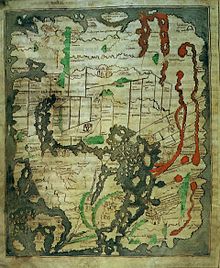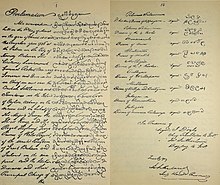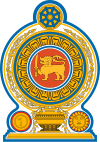Sri Lanka–United Kingdom relations
This article needs additional citations for verification. (November 2018) |
 | |
Sri Lanka |
United Kingdom |
|---|---|
| Diplomatic mission | |
High Commissioner James Dauris | |
Sri Lanka–United Kingdom relations, or British-Sri Lankan relations, are foreign relations between Sri Lanka and the United Kingdom.
Historical overview
Pre-colonial British rule
The relationship between Sri Lanka and Western Europe goes back thousands of years, as Sri Lanka was a stop along East–West trade routes during the times of Ancient Rome and Greece.
During the reign of Emperor
After the

Before Britain ruled the island of Sri Lanka (which they called Ceylon), British sailors reached the island. In the 17th century, the
British capture of Ceylon
During the Fourth Anglo-Dutch War, British forces led by Sir Edward Hughes captured Trincomalee (1782), a Dutch-controlled port in eastern Sri Lanka. Trincomalee was then captured by the French in the same year, followed by the subsequent Battle of Trincomalee between French and British fleets. It was restored to Dutch control after the Treaty of Paris in 1783.
During the Napoleonic Wars, Great Britain, fearing that French control of the Netherlands might cede Ceylon to the French, invaded and occupied the coastal areas of the island with little difficulty in 1796, ending Dutch Ceylon. In 1802, the Treaty of Amiens formally ceded the Dutch part of the island to Britain, and it became a crown colony known as British Ceylon.
From 1805 to 1815, Governor Thomas Maitland initiated legal and social reforms to strengthen the British power. These including a reform of the civil service to eliminate corruption, and the creation of a Ceylonese High Court based on the caste law. The Catholic population was enfranchised while the Dutch Reformed church lost its privileged position. Maitland also worked to undermine Buddhist authority and attract Europeans to the colony by offering grants of up to 4,000 acres (16 km2) in Ceylon.
Kandyan Wars
In 1803, the British invaded the Kingdom of Kandy in the First Kandyan War, but were repulsed.
In 1815, the British successfully invaded and occupied Kandy in the Second Kandyan War. The British discovered the hiding place of the last king of Kandy, Sri Vrikrama Rajasinha, who was then exiled and imprisoned in Vellore Fort in India, where he died 17 years later, in 1842. A treaty called the Kandyan Convention was signed, which stated the terms under which the Kandyans would live as a British protectorate. It declared that Buddhism would be protected by the British Crown and Christianity would not be imposed on the population. The treaty ended over 2,300 years of Sri Lankan independence.
The Kandyans rebelled against the British in the
British rule

British Ceylon was run as a colony affiliated to
The British colonial government favoured some ethnic groups—the semi-European
Post-independence
Ceylon continued to be a
President
Timeline of Sri Lanka-United Kingdom relations
Ancient
- 41–54 CE – Roman tax collector Annius Plocamus facilitates direct trade and first contact between Sri Lanka and the Roman Empire.
- 54–640 CE – Trade between the Roman Empire and Sri Lanka is common. Between 43–410 CE, Britain (mainly England and Wales) is part of the Roman Empire.
- 6th century–918 CE – The Anglo Saxon rulers of East Anglia engage in an international trading culture which stretches from the North Sea to the Baltic Sea and beyond. Many of the objects discovered at Sutton Hoo (a site dating back to Anglo-Saxon times) included garnets used in jewelry pieces which may have come from as far away as India and Sri Lanka.[12]

- c. 1040 – The Anglo-Saxon Cotton World Map shows westward as far as the British Isles and eastward as far as India and Taprobanen (the Anglo-Saxon name for Sri Lanka). At this time, Sri Lanka is the most distant land known to the Anglo-Saxons.[13]
- 1300 – The Hereford Mappa Mundi is a medieval English world map created by Richard of Haldringham. This map names Sri Lanka as Taphana (sometimes instead claimed to be Sumatra).
- 1357 – In the book of The Travels of St. Albans, England. Although the book is real (written in Anglo-Norman French), it is widely believed that "Sir John Mandeville" was not real, his travels never took place, and the book was possibly written by others, such as Jan de Langhe.[14]
Early British contact
- 1589 –The first known English visitor to arrive to Sri Lanka (then Ceylon) is a gentleman merchant, Ralph Fitch. He arrived in Ceylon on 6 March 1589 and stayed for five days, before leaving. He arrives back in London in 1591.[14]
- 1590s – English sailors and privateers cross to Ceylon, notably Sir James Lancaster
- 1658 – A British sea captain, Rajasinghe II. Knox escapes in 1679, after nineteen years of captivity,[3]and arrives back in London in 1680.
- 1667 – John Milton's epic poem Paradise Lost mentions the name of Taprobane
- 1681 – An Historical Relation of the Island Ceylon, a book written by Robert Knox after his experiences on Ceylon, is published in England. This book gives the British further knowledge about Ceylon.
British capture of Ceylon

- 1782 – The Treaty of Paris (1784)restores Ceylon back to Dutch control.
- 1795–1796 – British forces invade and take control of Trincomalee and the areas of Dutch Ceylon.
- 1802 – The Treaty of Amiens formally cedes the Dutch areas of Ceylon to Britain.
 This section may contain an excessive amount of intricate detail that may interest only a particular audience. (December 2022)
This section may contain an excessive amount of intricate detail that may interest only a particular audience. (December 2022) - 1803–1805 – The British started to invade the Sinhalese ruled areas of the Kingdom of Kandy during the Kandyan Wars, however, they were repulsed. After fierce fighting the British force found Kandy deserted in February 1803. They swiftly established a garrison, crowned Muttusami as the new, puppet, king of Kandy, and set about subduing the remainder of the kingdom. The Kandyans counter-attacked in March and seized Kandy.[15] In the meanwhile the retreating British army was defeated on the banks of the flooding Mahaveli river, leaving only four survivors.[16] Despite this setback the British still remained unquestioned masters of the lands they possessed, as the disastrous Kandyan counter-campaign later in the year proved. Equipped with a handful of captured six-pound cannon, the Kandyan army advanced through the mountain passes as far as the city of Hanwella.[17] Here the army was utterly routed by superior British firepower, forcing Sri Vikrama Rajasinghe to flee back into the mountains. A general rebellion that had erupted in British-controlled territory on hearing of the Kandyan invasion was suppressed. Frederick North, governor of Ceylon from 1798 to 1805, maintained pressure on the Kandyan frontier with numerous attacks, in 1804 dispatched a force under Captain Arthur Johnston towards Kandy. In a pattern that had become clear over the past two hundred or so years, the Kandyans once again defeated the British in the mountainous territory they called home. In 1805, emboldened by their successes, they captured Katuwana, a frontier town. This and the 1803 victory at the Battle of the Mahaveli, were to be Kandy's last, meaningful military successes.
- 1805–1815 – Legal and social reforms are enacted to strengthen the British power, led by governors Thomas Maitland and Robert Brownrigg.
- February 1815 – The Second Kandyan War.
- March 1815 – The Kandyan Convention, which results in the imprisonment of the Kandyan king in India and the start of the British Ceylon period.

British rule
- 1815 – Start of the George IIIbecomes the first British monarch to rule Ceylon.
- 1817–1818 – The Uva Rebellion, which ends with the complete annexation of the Kingdom of Kandy into British Ceylon.
- 1818 - Adam Sri Munni Ratna, a Buddhist monk from Sri Lanka, travelled to England with his cousin (also a Buddhist monk) while accompanying Sir Alexander Johnston in 1818. They were keen to learn Christianity as they were travelling to England. During their brief stay, the two monks were baptised and returned to Ceylon where they entered government service. This left a presence of Buddhism and Buddhists in the UK during the early 19th century.Anglican Church. [19]
Diaspora
There were about 129,076 Sri Lankan-born residents in the United Kingdom according to the 2011 census.[20] The majority of Sri Lankan immigrants in the United Kingdom live in London, with an estimated population of 84,000 in 2011.[21]
There is also a community of European descent in Sri Lanka called the Burghers. These are people descended from the Portuguese, Dutch, English, and other Europeans during the colonial era of Ceylon.
See also
References
- ^ "Archived copy" (PDF). www.dlib.pdn.ac.lk:8080. Archived from the original (PDF) on 21 September 2013. Retrieved 31 August 2022.
{{cite web}}: CS1 maint: archived copy as title (link) - ^ "Trade with the East, including first contacts with India - Queen Elizabeth I and the wider world - OCR B - GCSE History Revision - OCR B". BBC.
- ^ a b Chandrasena, Nimal. "An ancient village, a ruin by the sea and stories of pearls from Taprobane". www.sundaytimes.lk. Retrieved 2022-12-20.
- ^ "san.beck.org". Retrieved 23 October 2014.
- ^ "Robert Brownrigg: Information from". Answers.com. 2009-12-27. Retrieved 2012-08-17.
- ^ "New Page 1". Lankalibrary.com.
- ^ "Security Verification". 22 June 2011. Archived from the original on 2011-06-22. Retrieved 27 July 2022.
- ^ "Archived copy" (PDF). Archived from the original (PDF) on 2009-03-27. Retrieved 27 July 2022.
{{cite web}}: CS1 maint: archived copy as title (link) - ^ "President Sirisena meets Queen Elizabeth as UK vows to support Sri Lanka (Watch Video)". Newsfirst.lk. 11 March 2015.
- ^ "Ranil to head to London after Norway visit". Colombogazette.com. 2 October 2018.
- ^ "Crisis Meets Crisis: Ranil to Meet British Prime Minister Theresa May in London". Asianmirror.lk. Retrieved 27 July 2022.
- ^ "Who were the Anglo-Saxons?".
- ^ Juliana Marie Chapman (2009). Map, Manuscript, and Memory: The Emergence of an Anglo-Saxon Identity Between Origins and Apocalypse (MA thesis). Brigham Young University - Provo.
- ^ a b "Visions of an Island: Real and unreal".
- ^ "Toolserver:Homepage". Answers.com. Retrieved 2012-08-17.
- ^ "The Newsletters of the Friends of the Green Howards Regimental Museum". Archived from the original on 2006-06-15. Retrieved 2006-07-03.
- ^ [1] Archived February 12, 2006, at the Wayback Machine
- ^ "Photos: When two 19th-century Sinhalese Buddhist monks travelled to England to join the Church".
- ^ "Member Church - Ceylon". Retrieved 30 March 2023.
- ^ "2011 Census: Quick Statistics for England and Wales on National Identity, Passports Held and Country of Birth" (XLS). Ons.gov.uk. Retrieved 27 July 2022.
- S2CID 149483258. Retrieved 27 July 2022.

